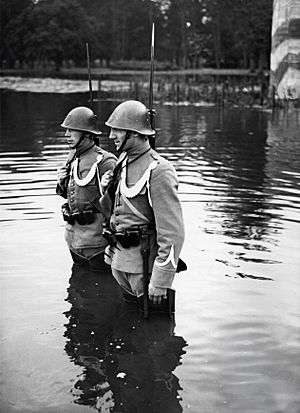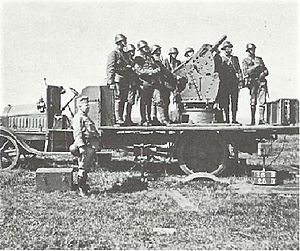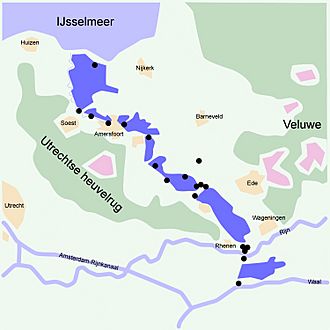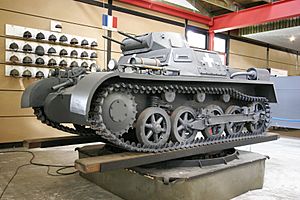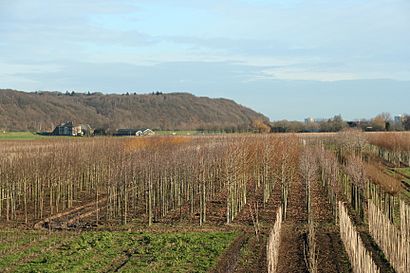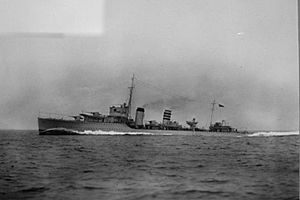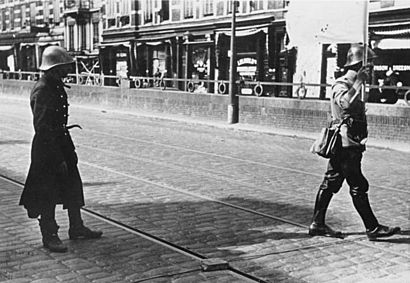German invasion of the Netherlands facts for kids
Quick facts for kids German invasion of the Netherlands |
|||||||
|---|---|---|---|---|---|---|---|
| Part of the Battle of France | |||||||
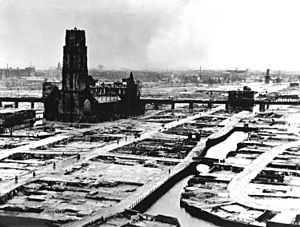 The centre of Rotterdam destroyed after bombing |
|||||||
|
|||||||
| Belligerents | |||||||
| Commanders and leaders | |||||||
|
|
||||||
| Strength | |||||||
| 280,000 men (9 divisions) 700 guns 1 tank 5 tankettes 32 armoured cars 145 aircraft |
750,000 men 22 divisions 1,378 guns 759 tanks 830 aircraft 6 armoured trains |
||||||
| Casualties and losses | |||||||
| 2,332 killed (Netherlands) 7,000 wounded 216 killed (France) 43 killed (Great Britain) |
2,032 killed 6,000–7,000 wounded 4 armoured trains destroyed 225–275 aircraft destroyed 1,350 captured (sent to England) |
||||||
| 2,000+ civilians killed | |||||||
The German invasion of the Netherlands was a quick military campaign during World War II. It was part of "Case Yellow," the plan for Nazi Germany to invade the Low Countries (Belgium, Luxembourg, and the Netherlands) and France. The main battle in the Netherlands lasted from May 10 to May 14, 1940.
During this invasion, Germany used paratroops for the first time on a large scale. These soldiers jumped from planes to capture important points like airfields near Rotterdam and The Hague. This helped the German ground troops move quickly and surprise the Dutch forces.
After a terrible bombing of Rotterdam by the German air force (the Luftwaffe) on May 14, the Germans threatened to bomb other Dutch cities. The Dutch military leaders knew they could not stop these attacks. So, they ordered the Royal Netherlands Army to stop fighting. The last parts of the Netherlands were freed in 1945.
Contents
Why Germany Attacked
The Start of the War
In 1939, the United Kingdom and France declared war on Germany after Germany invaded Poland. But for several months, there were no major land battles in Western Europe. This time was called the "Phoney War."
Adolf Hitler, Germany's leader, ordered plans to invade the Low Countries. He wanted to use them as a base against Great Britain. He also wanted to stop the Allies from attacking Germany through these countries.
The Netherlands Was Unprepared
The Dutch army was not ready for a big invasion. When Hitler came to power, the Netherlands slowly started to re-arm. But they were much slower than France or Belgium.
Dutch leaders did not want to make Germany angry because Germany was an important trading partner. They also faced a tough economic time called the Great Depression. Many believed Germany would respect Dutch neutrality, as it had in World War I.
As tensions grew in Europe, the Dutch government became more careful. In April 1939, they called up 100,000 men for military service.
After Germany invaded Poland in September 1939, the Netherlands hoped to stay neutral. They spent a lot of money on defense. But it was hard to get new military equipment during wartime. Some equipment was even ordered from Germany, which purposely delayed deliveries.
The Netherlands is located between France and Germany. This made it a likely path for either side to attack. Both the French and the Germans considered moving through the Netherlands.
Warnings and Preparations
After Germany invaded Norway and Denmark in April 1940, the Dutch military realized they might be next. They started to prepare fully for war. Border troops were put on high alert.
There were fears that German spies, called a "Fifth Column," had entered the Netherlands. The Dutch took steps to protect airfields and ports. On April 19, a state of emergency was declared. Still, many Dutch people hoped their country would be spared.
Dutch Army and Air Force
Not Ready for Modern War
The Netherlands had good conditions for defense, like a strong economy and educated people. But their army was not ready for modern war. Germany had tanks and dive bombers like the Stuka. The Dutch army had only 39 armored cars and five small tankettes.
The Dutch air force was part of the army. On May 10, it had only 155 aircraft. Many of these were older biplanes. Only 125 were ready to fly. The Dutch aircraft industry could have built more planes, but budget limits stopped this.
The Dutch army was also not well-trained. They had little practice fighting in large groups. Before the war, only a few young men were drafted into the military. Those who joined served for only 24 weeks, just enough for basic training. This was later increased to eleven months.
By May 1940, the Dutch army was not ready for battle. It could not launch a major attack. German generals thought they could conquer the main part of the Netherlands in just three to five days.
Dutch Defenses
For centuries, the Netherlands used a defense system called the Hollandic Water Line. This system protected major cities by flooding parts of the countryside. In 1940, this line was updated with new pillboxes. The area west of this line was called Fortress Holland. It was protected by floods, a large lake, and three wide rivers. The Dutch hoped this fortress could hold out for a long time.
In 1939, a new main defense line (MDL) was built further east. This included the Grebbelinie (Grebbe Line) in the north and the Peel-Raamstelling (Peel-Raam Position) in the south. These lines were also reinforced with pillboxes.
Failed Coordination with Allies
The Dutch tried to secretly work with Belgium and France to plan a common defense. But these talks failed because of disagreements on strategy.
Belgium had already made plans with the Allies. The Dutch wanted Belgium to connect their defenses to the Peel-Raam Position. But the Belgians refused unless the Dutch sent more troops to Limburg, which the Dutch could not do.
The French commander, General Maurice Gamelin, wanted to include the Dutch in his defense plans. But he would not send his troops far into the Netherlands unless the Dutch officially joined the Allies. The Dutch refused.
General Winkelman, the Dutch commander, secretly decided to abandon the Peel-Raam Position if Germany attacked. He planned to move his troops to a new line further west.
After the German use of airborne troops in Norway and Denmark, the Dutch worried about similar attacks. They placed five infantry battalions at major ports and airbases, including The Hague and Rotterdam airfields. These were supported by anti-aircraft guns and armored cars.
German Attack Plans
The Blitzkrieg Strategy
Germany decided to conquer all of the Netherlands. Hermann Göring, head of the German air force, wanted Dutch airfields to use against Britain. A quick victory would also free up troops for other fronts.
The German 18th Army, the weakest German army in the operation, was assigned to invade the Netherlands. It had four regular infantry divisions and three reserve divisions. Most of these soldiers were not well-trained.
To make up for their lack of numbers, the Germans used special forces. They had the 1st Cavalry Division and elite SS units like the SS-Verfügungsdivision.
The Germans also used two airborne divisions: paratroopers and air-landed infantry. Their plan, called Fall Festung, was to capture the airfields around The Hague. They hoped to quickly seize the Dutch government and Queen Wilhelmina. If that failed, they would secure bridges at Rotterdam, Dordrecht, and Moerdijk. This would allow German tanks to quickly relieve the airborne troops from the south. The German 9th Panzer Division would lead this tank advance.
This plan was a true example of Blitzkrieg (lightning war). It was a high-risk strategy designed for a fast, surprising victory.
The Oster Affair
Some German officers did not like the Nazi regime or the idea of invading neutral countries. One officer, Colonel Hans Oster, secretly passed information to the Dutch military in Berlin. This included the date of the invasion.
However, the attack was delayed several times due to weather. This made the Dutch government doubt the warnings. Even though Oster correctly predicted the attack on Denmark and Norway, his warnings about the Netherlands were largely ignored. On May 9, Oster called his friend again, saying, "Tomorrow, at dawn." Dutch troops were put on alert.
The Battle Begins
May 10: Surprise Attack
On the morning of May 10, 1940, the Dutch woke up to the sound of German planes. Germany had attacked the Netherlands, Belgium, France, and Luxembourg without declaring war.
German planes first flew over the Netherlands, making the Dutch think they were heading for England. But then they turned back to attack Dutch airfields. Many Dutch planes were destroyed on the ground. The Dutch air force was left with only 70 aircraft by the end of the day.
Immediately after the bombings, German paratroopers landed near the airfields. Many German transport planes were shot down or crashed during landing.
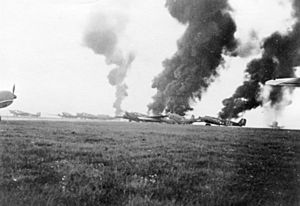
The attack on The Hague failed. Dutch armored cars and machine guns destroyed many German transport planes. The airfields became blocked with wrecks. The paratroopers could not capture The Hague and were pushed back by Dutch artillery.
The attack on Rotterdam was more successful. German seaplanes landed in the city center, and soldiers captured the Willemsbrug, a key bridge. Airborne troops also attacked the Waalhaven airfield south of the city. After confused fighting, the Dutch defenders were overwhelmed. The Germans then moved to capture other vital bridges. The Dutch navy tried to intervene, but their ships were bombed.
German commandos, some dressed as Dutch police, tried to capture bridges over the IJssel and Maas rivers. Most of these attempts failed, and the bridges were blown up by the Dutch. However, the Gennep railway bridge was captured. A German armored train crossed it, bringing infantry behind the Dutch defense line.
The Dutch troops in the Peel-Raam Position began to retreat. The Light Division, the Dutch army's only mobile force, was ordered to counterattack the German airborne troops in Rotterdam. But they could not cross the river Noord because the Germans had defended the bridge.
In North Brabant, the French army expected the Dutch to hold the Peel-Raam Position for several days. But the Dutch forces there were already retreating to a new, unprepared line. The Germans quickly crossed this new line.
In the North, German cavalry advanced quickly, blowing up many bridges. In the far south, German forces quickly overran the province of Limburg, capturing Maastricht.
May 11: Dutch Struggles
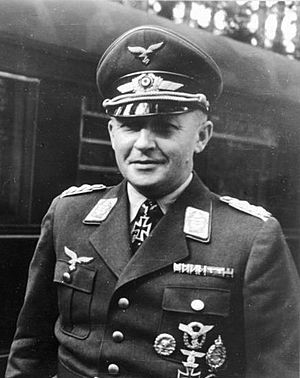
On May 11, General Winkelman wanted to defeat the German airborne troops and help the French build a strong defense line. But little was achieved.
The Dutch Light Division's counterattack against the airborne troops in Rotterdam failed. They could not cross the river Noord. Attempts to attack the Moerdijk bridgehead also failed.
In Rotterdam, Dutch marines tried to dislodge the Germans from the Willemsbrug, but they could not. The German airborne troops around The Hague also held their ground.
In North Brabant, the French army was surprised that the Dutch defenses had fallen so quickly. The French began to withdraw their left flank. This created a gap that the Germans could exploit.
On the Grebbe Line in the east, German SS troops attacked. They broke through the Dutch outpost line. The Dutch commander did not realize the seriousness of the attack. A planned Dutch counterattack failed due to confusion and lack of preparation.
In the North, German cavalry reached the Wons Position, the final Dutch defense line. Most Dutch troops had already left the area.
May 12: German Breakthrough
On May 12, General Winkelman was still hopeful, but his hopes were soon crushed.
The German 9th Panzer Division, which had been delayed, now advanced quickly. The French army, fearing a threat to their flank, ordered a full withdrawal from North Brabant. This left the route to the Moerdijk bridges open. German armored cars reached the bridges, cutting off Fortress Holland from the main Allied forces.
The Dutch Light Division tried to recapture the Island of Dordrecht but ran into German tanks. Many Dutch soldiers were killed or captured. The Dutch troops were forced to retreat from the island.
In Rotterdam and The Hague, the isolated German paratroopers continued to hold out.
In the east, the Germans launched a major attack on the Grebbe Line. SS troops broke through the main Dutch line. A Dutch counterattack failed, and the Dutch defenders panicked and fled. An 8-kilometer wide gap appeared in the Dutch defenses. The Dutch army command lost control. General Van Voorst tot Voorst ordered the army to abandon the Grebbe Line and retreat to the New Holland Water Line.
In the North, the Germans attacked the Kornwerderzand Position, a strong fortress on the Enclosure Dike. But the Dutch defenders held their ground.
General Winkelman learned that German tanks had linked up with the paratroopers at Moerdijk. He realized the German strategy. He ordered oil reserves to be set on fire. The Dutch government asked Winston Churchill for British divisions, but he had none to send.
The Final Days
May 13: Retreat and Royal Departure
On the morning of May 13, General Winkelman told the Dutch government that the situation was critical. The Dutch army was cut off from the Allies, and no major Allied help was coming. He believed a long resistance was not possible.
The cabinet decided to continue fighting for now, but gave Winkelman permission to surrender when needed. They also decided that Queen Wilhelmina must be safe. She left from Hook of Holland on a British destroyer and went to England.
Princess Juliana, the Queen's daughter, had already left for England the day before. After discussions, the rest of the Dutch government also left to form a government-in-exile in London. They gave all power in the homeland to Winkelman.
German tanks crossed the Moerdijk bridge. The Dutch tried to stop them with bombs and artillery, but the bridge was only slightly damaged. The Light Division tried to cut off the German advance but was met by German tanks and forced to retreat.
In Rotterdam, Dutch marines made a last attempt to blow up the Willemsbrug but failed.
In the North, the Germans tried to attack the Kornwerderzand Position again. But Dutch artillery and anti-aircraft guns forced them back.
In the East, the Dutch army successfully retreated from the Grebbe Line to the New Holland Water Line.
May 14: Rotterdam Bombing and Surrender
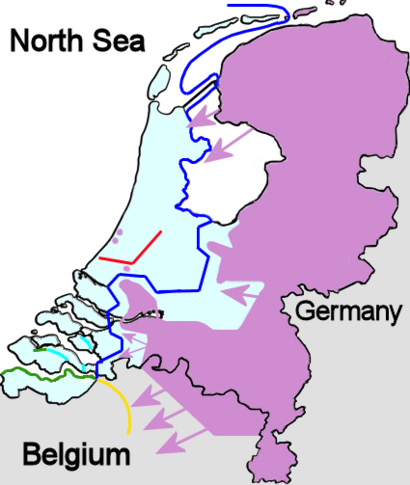
On May 14, General Winkelman still hoped to continue fighting. But the Germans planned a massive air attack on Rotterdam. German commanders wanted to break Dutch resistance quickly.
At 9:00 AM, a German messenger gave an ultimatum to the Dutch commander in Rotterdam, Colonel Pieter Scharroo. It demanded the city's surrender within two hours, or "the severest means of annihilation" would be used. Scharroo asked Winkelman for orders. Winkelman told him to gain time.
Around 1:20 PM, two groups of German bombers arrived. They had not received the order to stop the attack. They dropped 1,308 bombs, destroying the inner city of Rotterdam and killing 814 civilians. About 24,000 houses were destroyed, leaving 80,000 people homeless.
At 3:50 PM, Scharroo surrendered Rotterdam. The German air force commander, Hermann Göring, had ordered a second bombing unless the city was fully occupied. But the bombers were called back just in time.
Winkelman decided to surrender the Dutch army. He concluded that Germany would destroy any city that resisted. To avoid more suffering, he ordered all army units to destroy their weapons and surrender. At 5:00 AM on May 15, Winkelman met with the German commander to sign the surrender document. Only the armed forces in the Netherlands, except for the province of Zeeland, surrendered.
Fighting in Zeeland
The province of Zeeland in the southwest continued to fight with French troops. Dutch forces there had eight battalions. The area was important because it controlled access to Antwerp, a major port.
French troops arrived to help defend Zeeland. But cooperation between the Dutch and French was difficult. On May 14, German SS troops reached the Bath Position in Zeeland. The Dutch defenders, hearing about the surrender, fled.
On May 15, the Germans attacked the Zanddijk Position. The Dutch defenders fled after a bombing. On May 16, the Germans crossed the Canal through Zuid-Beveland. French troops tried to hold the Sloedam, but the Germans established a foothold.
On May 17, the Germans demanded the surrender of Walcheren island. When refused, they bombed Arnemuiden and Flushing. Middelburg, the capital, was heavily shelled. The French defenders were demoralized, and the Germans broke through. Most French troops were evacuated by sea.
By May 19, all Dutch troops were withdrawn from Zeelandic Flanders to Belgium. By May 27, all of Zeelandic Flanders was occupied.
Aftermath
After the Dutch defeat, Queen Wilhelmina formed a government-in-exile in Britain. The German occupation of the Netherlands officially began on May 17, 1940.
It took five years for the entire country to be freed. During this time, over 210,000 people in the Netherlands died because of the war. This included 104,000 Jews and other minorities who were victims of genocide. Many others died from poor nutrition or limited medical care.
See also
 In Spanish: Batalla de los Países Bajos para niños
In Spanish: Batalla de los Países Bajos para niños
- Marine memorial
- List of Dutch military equipment of World War II
- List of German military equipment of World War II
- List of French military equipment of World War II
- List of British military equipment of World War II
Images for kids


